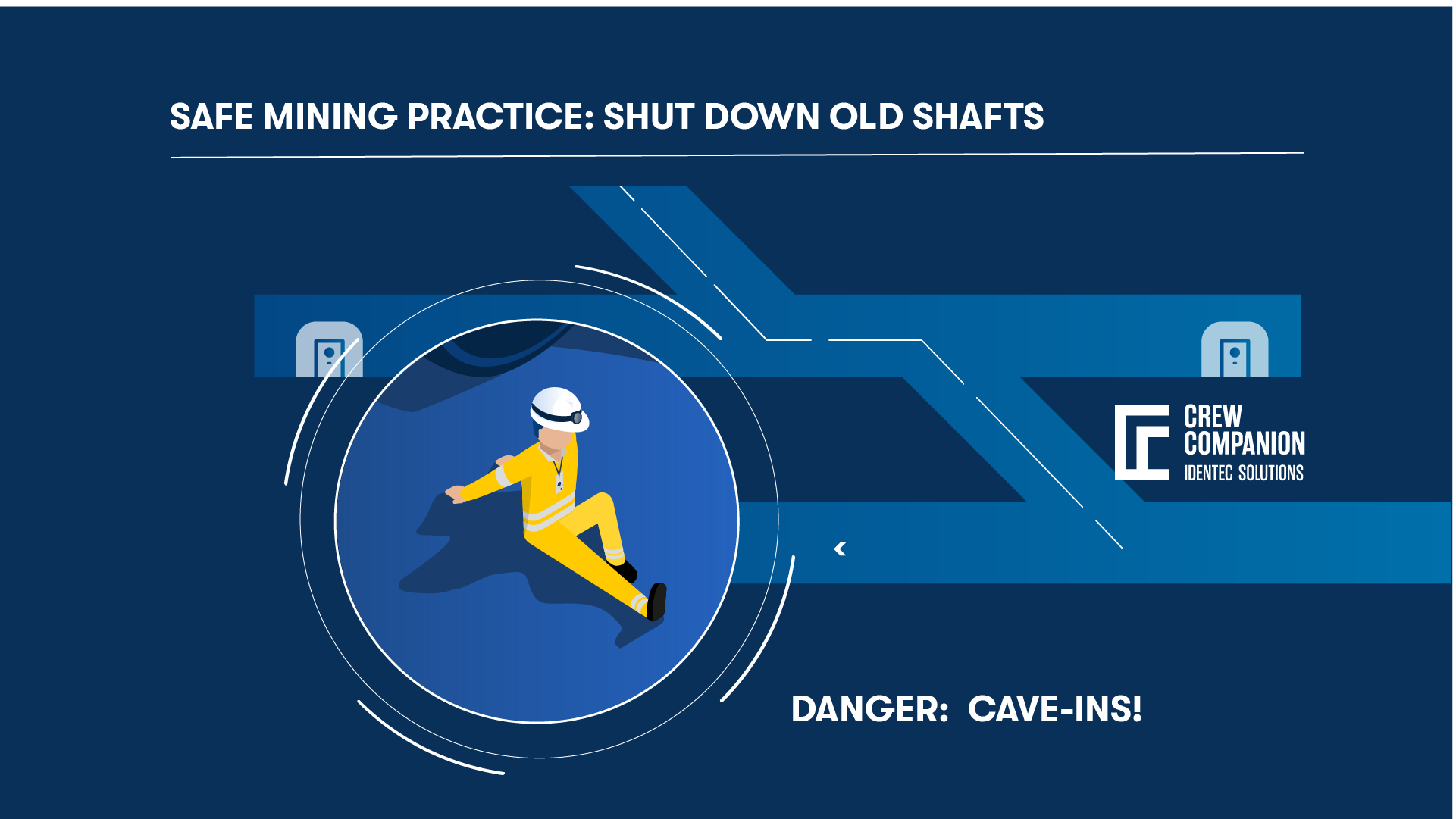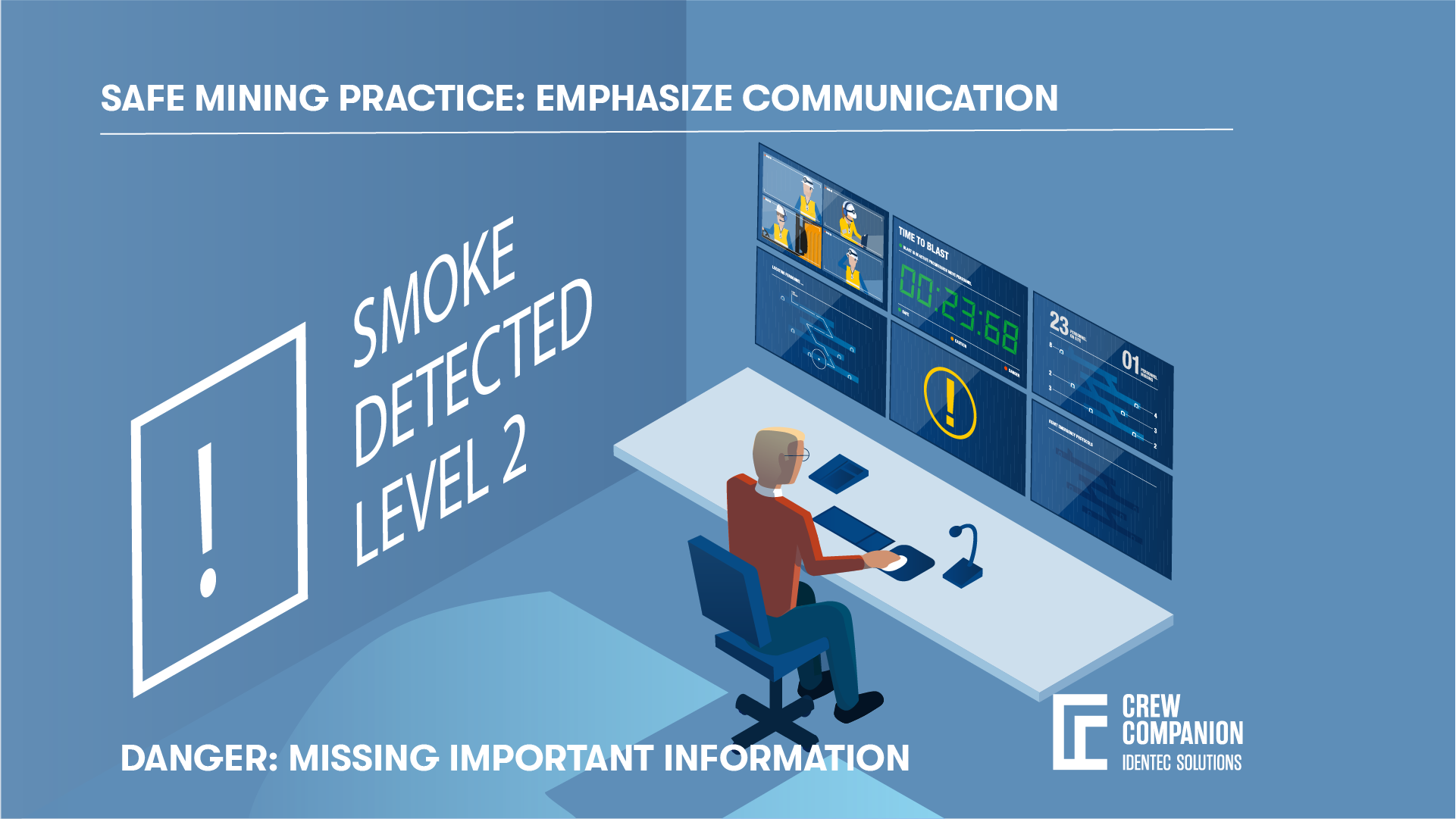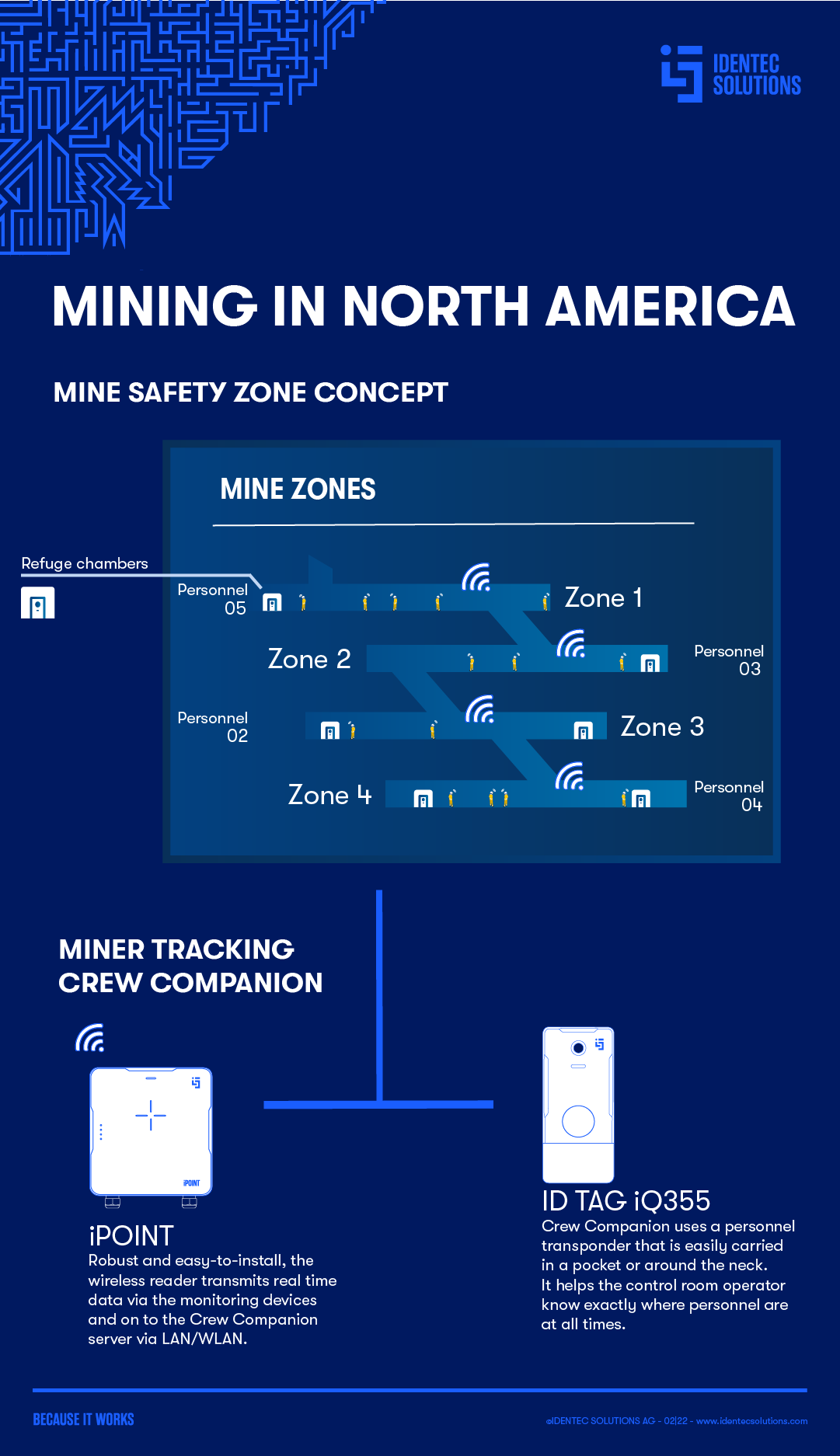Safety framework mining: How to integrate transponders?
| Written by Geir Nerbø

No video selected
Select a video type in the sidebar.
Table of contents:
- How To Raise Safety Standards With A Framework?
- Post-Accident Survivability: Tracking Miners
- What Is The Best Way To Integrate Transponders In A Mining Safety Framework?
- Crew Companion Is An Integrated Mining Safety Framework, Including Transponders
- FAQs
- Glossary
How to Raise Safety Standards With a Framework?
The way to zero harm is long. In 1977, when the Mine Act in the US was passed, almost 250 miners died that year. It was not a historic year in terms of fatalities; it was rather an average year for the US mining industry. After enforcing the Mine Act, the number plummeted to 73 the following year and became stable at 50 for the next years.
The Federal Mine Safety and Health Act of 1971 was built on the 1969 Coal Mine Health and Safety Act. This mining safety framework consists of five parts. The first block is about comprehensive health and safety standards. These are standards that have been built up over time and rule everything in the mine. The mine operator is responsible for compliance with those standards, and employee misconduct is not a defence to a violation. (source)
Learn more about miners' safety in our latest whitepaper!

The second building block is mandatory training. For underground mines, there is a requirement for forty hours of training; for open-pit mines, for twenty-four hours of training. Also, annual refresher training and hazard training are required. Training is focused on safety performance and mandatory annual instruction in miners' rights.
The third block is mandatory inspections. Federal inspectors visit underground mines four times a year and surface mines twice a year to conduct complete checks. Mandatory citations of violations are the fourth part of the Mine Act, and the fifth is whistleblower protection for miners who make safety complaints.
Following the tragedies of Sago, Aracoma, Darby and Crandall Canyon, the focus of the safety framework shifted once more to reduce the number of fatalities in coal and non-coal mining. It was about post-accident survivability.
Post-accident survivability: Tracking miners
The Miner Act focused on the prevention of accidents. However, what can be done to ensure miners' chances of post-accident survivability if this fails and an accident happens? The Miner Act of 2006 addressed several aspects of improving post-accident survivability: the requirement for self-contained self-rescuers (SCSRs) breathing devices (at least two devices per miner); lifelines to guide miners out of the mine when visibility goes down to zero; emergency response plans are also required which forced mine operators to have procedures in place to assist miners in escape and trapped situations. The critical feature of every plan is the provision of breathable air.
The Miner Act also handled the communications problem in two ways. First, one must be able to intercommunicate from the surface to the miners underground and back via a redundant, hard-wired system that can persist in an explosion. In future, a wireless system should become quasi-standard. The second aspect is to know exactly where the affected miners are. The tracking requirement is done mainly through a dispatcher system, where miners, as they travel about the mine, will check in with the surface control room through the mine telephone system to know about their location.
The zone concept follows the same idea of localisation without the need to contact the control room individually. Transponders interact with installed readers and transmit the miner's position automatically and constantly. Attempts to automate these basic but required tasks are reflected in a wide range of products. Barcode and card-based systems were once popular. However, as RFID enjoys several advantages over bar-code methods, it has become the better choice for many security and safety situations.

And the Miner Act of 2006? It was a step in the right direction: the average fatality fell to 25 per year in US mines (find more about Risk Management and Wearables)
What is the best Way to integrate transponders in a mining safety framework?
Imagine a typical mine with several tunnel zones. As discussed above, management must know which zone (shaft, tunnel) each worker is in at all times. Neither workers nor management would accept a system that required all personnel to leave their vehicles so they could pull their ID cards when driving through the zones. Such a system is cumbersome and results in time inefficiency: stopping at every half-mile of the tunnel would be absurd. Typical road tolling systems cannot address the problem as they can not read all the tags quickly.
In contrast, a system that can accurately read the tags of an entire busload of workers passing 40 km/h (25 mph) is suitable. Active RFID readers must be tuned correctly, and the right software must be used to achieve this. Therefore, a solution that integrates both hardware and software is preferred. Such a solution allows for defining and adjusting zones while the system operates; it also locates the individual transponder when zones overlap.
A tracking concept needs a definition of geographical zones and at least one antenna in each zone. Providing several antennas gives you more accurate transponder positioning using signal strength measurement. However, there are reflections from walls and equipment to consider. You want to locate the transponders on the correct level in buildings or process industry facilities involving multiple vertical levels. Software algorithms must work together with the right equipment to avoid several antennas simultaneously reading a tag or allocating the transponder to one zone for a transponder within a range of several antennas.
Active RFID systems present a versatile safety, access control, and security tool. It must be set up well and have a simple user and maintenance interface to work in critical, stressful situations. Such an RFID system must be connected to the administrative and process control network to multiply the possibilities and potential payback of such an investment, namely, communication to and from an (external) emergency centre.
Further reading: Mining safety use cases, technologies and real-world scenarios

Crew Companion is an integrated mining safety framework, including transponders
A basic RFID system consists of a reader, an antenna, and a transponder, whereas the reader is both a transceiver and a decoder. When it transmits a signal through the antenna, the transponder answers or reflects the information embedded in it. The advantage over bar-code systems is that the reader does not have to "see" the transponder or code visually. The reader is connected to the Crew Companion server and collects all data to be monitored over the Crew Companion client.
An integrated transponders' safety framework in today's mines should have these features:
- Graphical user interfaces with actual maps of the site, building, or tunnel system. Maps can be added and edited in real-time.
- Zones, reading ranges, etc., can be added, removed, or adjusted in real-time while the system runs.
- Zones can be defined as in/out zones, allowing a quick overview of personnel inside and outside a primary site structure, such as tunnels of a mine.
- Reports that can be generated at predefined times for various criteria.
- Integration with other systems, such as fire alarms, gates, and process control systems.
- Data logging to backtrack transponder movements (in countries permitting this, within personal privacy rules).
Many mining and tunnelling companies use Crew Companion as a vital part of their safety concept. One example is Europe's biggest iron ore mine in Kiruna, Sweden, known for its sustainable mining approach. Do you want to learn more?
FAQ
How do transponders enhance the safety framework in mining operations?
The transponders very strongly support the mining safety framework through real-time tracking and monitoring of miners, which is very important in effective emergency response and daily operational safety. A transponder within a mining safety framework interacts with strategically placed RFID readers in the mine, continuously sending location information related to each worker. This eliminates manual check-ins and allows for quick location updates, which could prove critical in emergencies such as a cave-in or fires. Real-time data received through transponders facilitates speedy and informed decision-making, ensuring that rescue operations coordination runs smoothly. More importantly, integration with transponders can help optimise everyday safety procedures through movement patterns and places with potential safety risk areas. This proactive stance, built to enhance immediate response capabilities, constantly improves toward the refinement of the safety protocols, culminating in a much safer mining environment and supporting the umbrella goal of zero harm in mining operations.
What challenges might arise when integrating transponders into a mining safety framework, and how can they be mitigated?
Incorporating transponders in a mining safety framework raises technical, operational, and possible privacy issues. Technically, one important challenge would be reliable communication between the transponders and RFID readers in clouds of interfering environments with metal structures and machinery that are ever in motion, distorting the signals in a mine. In this respect, the software algorithms should be of immense sophistication in signal handling during deployment in mines, and use multiple antennas to get better signal accuracy and coverage. Operationally, implementation of the transponders with minimum disturbances may be achieved by phased-in approaches along with subjecting the employees to comprehensive staff training. Regardful policies on usage may compromise the privacy issues of tracking workers. These policies must ensure that the data collected through tracking is only used for safety and operational reasons. Mining operations, through effective strategic planning and stakeholder engagement, can appropriately deal with these challenges and seamlessly adopt transponders that can improve their safety and/or efficiency without losing trust or compliance from the workers.
Dive deeper into our core topic: Mining safety!
Glossary
Shaft mining is the type of excavation to reaches mineral deposits deep within the Earth through digging tunnels straight down from the surface. The term "shaft" actually describes a vertical passage built for mining or engineering purposes.
When the tunnel starts at the surface, it is termed a shaft. A sub-shaft is a vertical tunnel which begins underground and runs upwards. The depth of a shaft is decided by the project's purpose. Usually, in civil engineering, shallow shafts are developed for public infrastructure projects like sewer tunnels, while deep shafts are developed to reach the ore body underground. (2)
Sources:
(1) https://www.cdc.gov/Niosh/mining/UserFiles/works/pdfs/sffpe.pdf
(2) https://anundergroundminer.com/blog/what-is-a-mine-shaft
Note: This article was updated on the 5th of August 2025.

Author
Mark Buzinkay, Head of Marketing
Mark Buzinkay holds a PhD in Virtual Anthropology, a Master in Business Administration (Telecommunications Mgmt), a Master of Science in Information Management and a Master of Arts in History, Sociology and Philosophy. Mark spent most of his professional career developing and creating business ideas - from a marketing, organisational and process point of view. He is fascinated by the digital transformation of industries, especially manufacturing and logistics. Mark writes mainly about Industry 4.0, maritime logistics, process and change management, innovations onshore and offshore, and the digital transformation in general.





